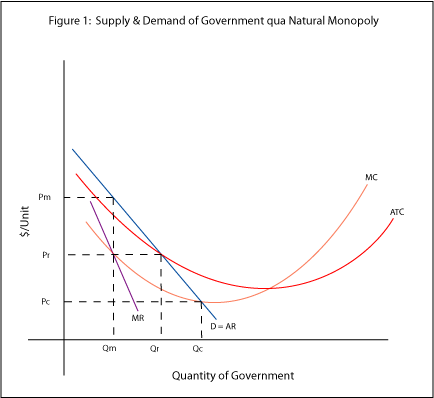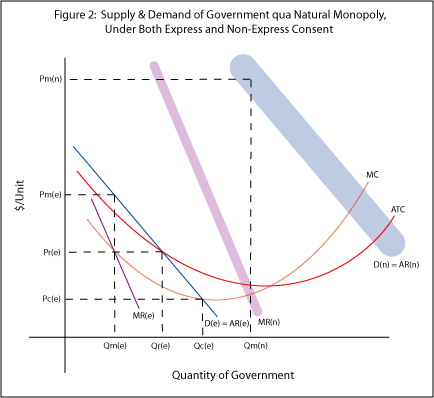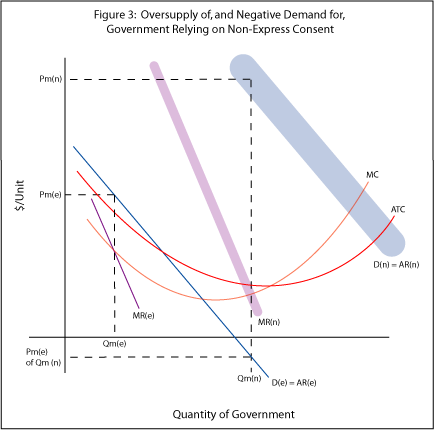Instructional Goals: You will understand:
- How to measure consumers' surplus and deadweight loss.
- What a residual demand curve is and how to use one.
- The importance of property rights for exchange to take place; the nature of externalities or spillovers, and the Coase theorem.
- The difference between a buyer and a seller.
Lecture 2:30 PM to 4:00
Consumption is the purpose of all economic activity. Work is economically meaningful only if it produces something of value to someone -- that is, only if there is a consumer out there who wants to buy it. What is true of the economy as a whole, is equally true for the organizations that comprise it. This principle is not a call to hedonistic self indulgence. Putting the customer first is a discipline competition imposes upon producers. You can work as hard as you want, but unless you're creating more value than you are expending, you are wasting your resources and will eventually be put out of business. It is this discipline that drives producers to create more and more value for less and less effort -- in other words, make us richer.
Increasing competition tightens the screws of market discipline -- benefiting consumers, but making it harder for organizations to earn an honest buck, i.e., more than normal returns on one's investment.
Under perfect competition YOU cannot earn more than a normal return on your investment. So what are the characteristics of perfect competition?
- Perfectly homogeneous goods. All organizations supplying the market sell an identical product or, at the very least, consumers view their products as identical and are indifferent between them. A corollary of this characteristic is: Perfect divisibility of output.
- Perfect information. Producers and consumers, buyers and sellers, have all relevant information about all prices, costs, and quality of all products. A corollary of this characteristic is: No transaction costs. Buyers and sellers do not encounter search, bargaining/negotiation, enforcement or monitoring costs; delivery is free and occurs precisely when needed. Another corollary is: No externalities or spillover costs and benefits that are not captured by the parties to the exchange.
- Price taking. Buyers and sellers cannot individually influence the price at which products can be purchased or sold. The corollary of this characteristic is: Free entry and exit, that is, organizations can enter or exit a market without incurring a cost.
Obviously, you will want to earn the highest possible return on your investment. The only way to do so is to change markets so these conditions do not obtain (e.g., consumer indifference) or take advantage of situations where they cannot (e.g., perfect information).
As you learned in economics, a demand schedule reflects willingness and ability to pay and a supply schedule, willingness and ability to sell. The sum of the difference between what customers were willing to pay and the price paid represents the exchange value provided by a product. It is called a consumer surplus and is measured by the area under the demand schedule and above the price line. Conversely, the area above the supply schedule and below the price line is the producer surplus.
An unconstrained profit-maximizing monopoly, producing a perfectly homogeneous product and charging a single price, would set output and price to equate marginal revenue with marginal cost, resulting in a substantial deadweight loss.
The following figure shows the case of a revenue (not profit) maximizing natural monopoly. A revenue maximizing entity operates where marginal revenue is zero. A so-called natural monopoly is one in which average total cost (ATC) decreases at a decreasing rate throughout the relevant range of output. This is so in the instance shown below because marginal cost is constant, while large capacity (or fixed) costs are spread over total output. Under these conditions, where a single price is charged for each unit of output, the consequent deadweight loss is substantial.
Natural monopolies are not necessarily inefficient -- although lack of competion encourages sloth and other bad things. Given perfect information, consumers could band together and bribe the potential monopolist to offer the optimal quantity of of the good or service in question.
Elasticities and the Residual Demand Curve This course makes repeated use of two related concepts to analyze both price competitive and noncompetitive industries: (1) price elasticity of demand or supply and (2) the demand curve facing a single organization's product or service: the residual demand curve. The price elasticity of supply or demand aids in understanding how an industry is likely to respond to changes in demand or supply. The residual demand facing a single organization allows you to understand and exploit the demand for your service and products. The following discussion explains how the elasticity of the residual demand curve is related to the assumption that a price competitive organization cannot affect price.
Elasticities of Demand and Supply
If either the demand or supply curve shifts, the competitive equilibrium changes, and the shapes of the demand and supply curves influence how the new equilibrium compares to the old. For example, if the demand curve is perfectly flat, the competitive price remains unchanged, even if the supply curve shifts radically.
One concept used to characterize the shape of demand or supply curves is the price elasticity of demand or supply (often the word price is omitted). The price elasticity of demand at price p and quantity Q is approximately the percentage change in quantity divided by the percentage change in price (ÆQ/Q) ÷ Æp/p) = (p/Q) (ÆQ/Æp).
Because the elasticity is the ratio of two percentage terms, the elasticity is invariant to changes in scale of either price or quantity (it is a pure number without scale itself). For example, if price is measured in cents rather than dollars, the elasticity is unchanged even though the slope of the demand curve, ÆQ/Æp, does change. The technical definition of the price elasticity is (p/Q)(dQ/dp). Similarly, the elasticity of supply is (approximately) the percentage change in quantity supplied in response to a 1 percent change in price. The elasticity of demand is a negative number, and the elasticity of supply is usually, but not always, positive.
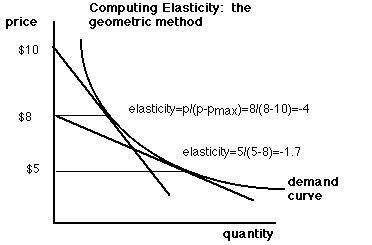
If a 1 percent increase in price leads to a more than a 1 percent reduction in the quantity demanded (so that the total amount paid in the market falls) a demand curve is called elastic. That is, an elastic demand curve has an absolute value of the elasticity of demand greater than one (the absolute values of 1 and -1 are both 1). It is common to omit the phrase the absolute value of when discussing the price elasticity of demand. The statement, "The price elasticity of demand is 2," is interpreted to mean that the price elasticity is -2.
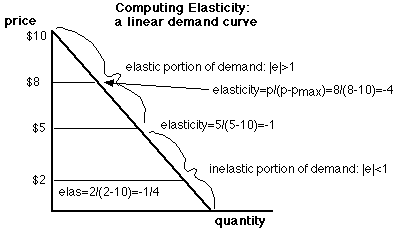
When the absolute value of the elasticity of demand is 1, the demand curve is of unitary elasticity. In that case, a 1 percent change in price causes a 1 percent change in the quantity demanded, and the total amount paid (total revenues) remains constant. If the absolute value of the elasticity of demand is less than 1, the demand curve is inelastic; a 1 percent increase in price causes less than a 1 percent decline in the quantity demanded, and the total amount paid rises.

In general, the elasticities of demand and supply depend upon many economic factors, such as the level of output, the availability of substitute products, and the ease with which suppliers can alter production. For example, as more substitute products are available, consumers find it easier to substitute for a product if its price rises, which makes its demand curve more elastic. Similarly, the more flexible the production process of a organization, the more likely it is that the organization can greatly increase production in response to a price increase, which tends to increase the elasticity of supply.
Price Taking Among Price competitive Organizations and the Residual Demand Curve
Price competitive organizations are often described as price takers; they believe that they cannot affect the market price and must accept, or take, it as given. There are three equivalent ways to state this result, all of which are used in this course:
• A price competitive organization is a price taker.
• The demand curve facing a price competitive organization is horizontal at the market price.
• The elasticity of demand facing a price competitive organization is infinite.
A organization is a price-taker if it faces a horizontal demand curve, because a horizontal demand curve has an infinite price elasticity of demand. If a organization facing an infinite price elasticity raises its price even slightly, it loses all its sales. Alternatively stated, by lowering its quantity, the organization cannot cause the price to rise. In contrast, a organization facing a downward-sloping demand curve can raise its price by decreasing its output.
If the number of organizations in an industry (an industry is made up of all the organizations supplying products or services with identical attributes) is large, the demand curve facing any one of them is nearly horizontal (elasticity of demand is infinite) even though the demand curve facing the industry is downward sloping (elasticity is relatively small). Indeed, for most market demand curves, there do not have to be very many organizations in an industry for the elasticity of demand facing a particular organization to be large.
To show this result, it is necessary to determine the demand curve facing a particular organization: the residual demand curve. A organization sells to people whose demands are not met by the other organizations in the industry. For positive quantities of residual demand, the residual demand, D,(p), is the market demand, D(p), minus the supply of other organizations, So(p):
If So(p) is greater than D(p), Dr(p) is zero.
Figure 4.6b shows the market demand curve and the supply of all the organizations except one. The horizontal difference between the market demand curve and the supply of the other organizations is the residual demand facing a particular organization, Figure 4.6a. The horizontal difference is the quantity demanded by the market at a given price minus the supply of other organizations at that price.
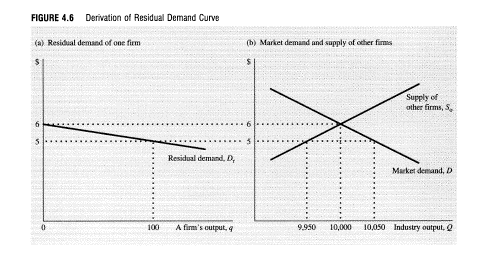
For example, in Figure 4.6b, at a price of $5, market demand is 10,050 units and the supply of the other organizations is 9,950 units. That is, the other organizations are not willing to meet the entire market demand at $5; the difference between demand and the supply of other organizations is 100 units. Thus, at $5, the organization's residual demand is 100 units. At $6, the supply of other organizations equals the market demand. The residual demand facing the organization in Figure 4.6a is zero. Were price to rise even higher, other organizations would be willing to supply even more than is demanded. Thus, at any price greater than or equal to $6, the organization in Figure 4.6a sells no units.
The residual demand curve facing the organization, Figure 4.6a, is much flatter than the market demand curve, Figure 4.6b. Similarly, the single organization's demand elasticity is much higher than the market elasticity. As drawn, the elasticity of demand for the individual organization, from $5 to $6, is -11, whereas the corresponding market arc elasticity of demand is -0.025. In other words, the organization's residual demand elasticity is 440 times as elastic as the market elasticity.
More generally, if there are n identical organizations in the industry, then the elasticity of demand facing any one organization i is
e i = e n - h o n /(n - 1),
where e is the market elasticity of demand (a negative number), h o is the elasticity of supply of the other organizations (a positive number), and (n -1) is the number of other organizations.
Thus for a given market elasticity, as the number of organizations in an industry, n, increases, the elasticity facing a single organization i, e i grows large in absolute value (more negative). Similarly, the larger the elasticity of supply of the other organizations,
or the more of these other organizations, the larger in absolute value (more negative) is the elasticity of demand facing organization i.
Table 4. 1 shows how the elasticity of demand facing a single organization varies with the number of organizations and the market elasticities, given that the elasticity of supply of other organizations is completely inelastic (h o = 0). For example, if the market elasticity is unitary (e = 1) and there are 50 organizations, then e i = -50. That is, if a organization were to increase its price by 1 percent, the quantity it sells would fall by about 50 percent. If there are 1000 organizations, e i = -500, so that if the organization were to raise its price by a tenth of a percent, the quantity it sells would fall by 50 percent. Thus, even if the market elasticity is completely inelastic, if there are a large number of organizations in the industry, the elasticity of demand facing a single organization is very large (see Example 4.2).
EXERCISES
1. Please draw figure so that the inverse demand schedule is Q = 100 - p (both the vertical and horizontal intercepts are at 100). Note that at p = 100, Q = 0; at p = 0, Q = 100; and at p = 50, q = 50.
2. Please draw figure so that the inverse supply schedule is Q = p. Note that at p = 100, Q = 100; at p = 0, Q = 0; and at p = $50, q = 50.
3. Find the competitive equilibrium price and quantity (set Q = p, 100 - p = p, 100 = 2p, p = ?, q = ?
4. Calculate total revenue (TR) = pQ =
5. Calculate consumers' surplus (100 - p)Q/2 =
6. Calculate producers' surplus pQ - C, where C = pQ/2 =
7. Draw identical figure to thone described in steps 1 & 2, but include marginal revenue schedule (MR) with the following equation Q = 50 - .5p
8. Calculate profit maximizing output (set Q = MR, 50 - .5p = p, 50 = 1.5p, Q = ).
9. Use the inverse demand schedule (Q = 100 - p) to calculate the profit maximizing price (set p = 100 - 33.33, p =
10. Calculate total revenue (TR) = pQ =
11. Calculate consumers' surplus (100 - p)Q/2 =
12. Calculate producers' surplus pQ - C, where C = pQ/2 =
13. Show calculation for deadweight loss D = $33.33 (16.67)/2 =
13. Calculate Price Elasticity, where p = $50, Q = 50, Price Elasticity = |?|; p = $75, Q = 25, Price Elasticity = |?|; p = $25, Q = 75, Price Elasticity = |?|
14. Calculate Price Elasticity, where p = $66.67, Q = 33.33, Price Elasticity = |?|
15. Using the inverse elasticity rule (Ramsey optimal pricing): p-mc/p = 1/|Price Elasticity| = calculate the optimal markup where Price Elasticity is |2| and marginal cost is $33.33
EXAMPLE 1
Assume a price competitive industry with free entry and exit. What would happen to industry output, optimal organizational scale (assuming all organizations had access to identically the same technologies), and the equilibrium price, if government imposed a fixed fee per year on each organization participating in the industry?
___________
Answer: The following figure shows that, starting from long-run normal-profit equilibrium, an increase in fixed costs raises average costs from AC1 to AC2. At the original price each organization would lose money, so some organizations would exit the industry (the number of organizations goes from n1 to n2). Remaining firms produce more than before (q1 instead of q2). Total output falls from Q1 = nq1 to Q2 = nq2. Price rises to P2.


